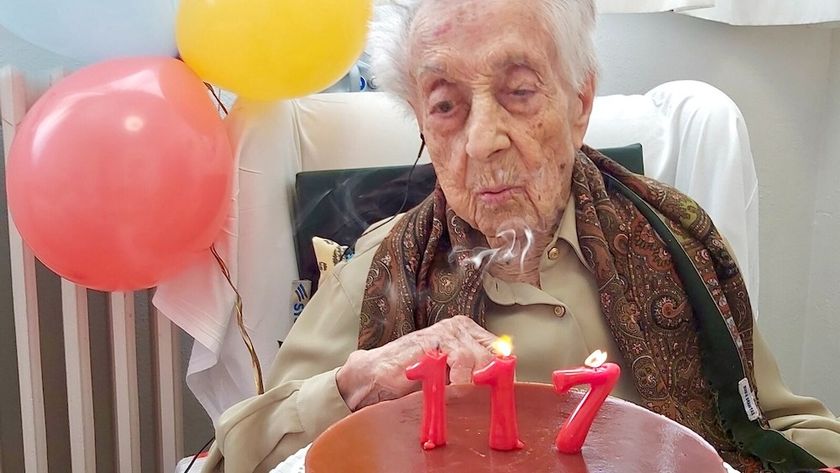In Recession's First Full Year, Life Expectancy Dropped

The average life expectancy in the United States in 2008 — the first full year of the recession — was 77.8 years, a slight drop from 2007, according to new government data.
Men's average life expectancy was 75.3 years in 2008, compared with 75.4 years in 2007, and women's average life expectancy was 80.3 years in 2008, compared with 80.4 years in 2007, according to the National Vital Statistics Report from the National Center for Health Statistics.
"Any small change in mortality statistics is important because that's a key indicator for society's well-being," said Dr. David Nash, dean of the Jefferson School of Population Health at Thomas Jefferson University in Philadelphia.
The finding may seem surprising because of all the technological advances in medicine, Nash told MyHealthNewsDaily. But medicine — services, drugs and hospitals — contributes only about 15 percent to a society's well-being, he said.
The other 85 percent is made up of societal issues such as the recession, crime, lack of education and lack of access to health care, which likely had an effect on overall life expectancy, he said.
Of the states, Hawaii had the lowest mortality rate in 2008, with 589 deaths per 100,000 people. West Virginia had the highest, with 958.1 deaths per 100,000 people, according to the report.
The country's death rate, however, also went down in 2008. About 760 people died per 100,000 people in 2007, compared to 758.7 deaths per 100,000 people in 2008, the report said.
Sign up for the Live Science daily newsletter now
Get the world’s most fascinating discoveries delivered straight to your inbox.
The National Vital Statistics Report used data from 99 percent of demographic and medical files for U.S. deaths in 2008.
Differing death rates
There were 2,473,018 deaths in 2008, which is 1.2 percent more than the number of people who died in 2007, the report said.
After adjusting for age, the death rate in 2008 hit a record low of 758.7 deaths per 100,000 people, which was 0.2 percent lower than the 2007 death rate , according to the report.
Nash said one reason fewer people may have died in 2008 is that, paradoxically, fewer people tend to go to the hospital during a recession, largely because they can't afford elective procedures. And health care associated infections kill 99,000 people a year, according to the Centers for Disease Control and Prevention.
"If we get fewer people in the hospital, we get fewer hospital-associated infections and fewer deaths," Nash said. "That'll lower the death rate."
Hispanics, Asian Pacific islanders, American Indians and Alaska natives had the lowest death rates out of all ethnicities measured in the report.
Compared with the death rate of non-Hispanic Caucasians, Asian Pacific islanders' death rate was 40 percent lower, Hispanics' death rate was 30 percent lower and American Indians and Alaska natives' death rate was 20 percent lower, according to the report.
The differences between ethnicities is hard to explain, but is likely because of a combination of behavioral factors, such as smoking and obesity, and uncontrollable incidents, like car accidents, Nash said.
The death rate decreased for infants, people ages 5 to 44, and people ages 65 to 74. However, there was an increase in the deaths for people ages 85 and older between 2007 and 2008, the report said.
Causes of death
Heart disease was the leading cause of death in the United States in 2008, just as it was in 2007, the study showed.
It was followed by cancer, lung disease, stroke, accidents and Alzheimer's disease, the report said.
But fewer people died of heart disease, and fewer died from the next five leading causes of death –cancer, stroke, accidents, diabetes and homicide.
A decrease in smoking could be a big factor in the decreases in death from these conditions, said Stan Glantz, a professor of medicine at the University of California, San Francisco, and director of the Center for Tobacco Control, Research and Education.
"Those are all diseases caused by smoking, so probably what you're seeing there is the effects of less smoking," Glantz told MyHealthNewsDaily.
However, death rates increased for six of the other leading causes of death. Those include lung disease,Alzheimer's disease, influenza and pneumonia, kidney disease, suicide, hypertension and hypertensive renal disease.
Glantz said the increase in deaths from Alzheimer's disease may actually be linked to the decrease in deaths from heart disease and cancer.
"More people are living long enough to get Alzheimer's because the smoking isn’t killing them, and they're not getting heart attacks in middle age," he said.
Pass it on: Our average life expectancy dropped slightly in 2008 from 2007.
- Who Lives to 100? Centenarian Facts
- Your Grip Strength and Your Balance Might be Clues to Your Mortality
- The 10 Deadliest Cancers and Why There's No Cure
Follow MyHealthNewsDaily staff writer Amanda Chan on Twitter @AmandaLChan.
This article was provided by MyHealthNewsDaily, a sister site to LiveScience.












